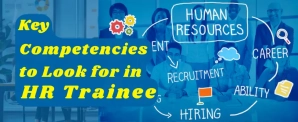Category
- Performance Management System
- Job Performance Standards
- Evaluation Procedure
- Employee Self Evaluation
- Training and Development Plan
- Performance Appraisal Forms
- Balanced Scorecard
- Bell Curve Appraisal
- Performance Appraisal
- 360 Degree Performance Appraisal
- Job Analysis
- Job Description
- Job Specification
- Performance Management Process
- Goal Setting for Performance Management
- Performance Planning
- SMART Goals
- Performance Appraisal Failure
- Performance Execution Phase
- Legal & Ethical Issues in Performance Appraisal system
- Performance Management Tools
- Performance Management Cycle
- Job Design
- Employee Engagement
- Job Satisfaction
Job Design
Job design is a research and analysis of a job in consultation with peers, managers, and management to compile the entire job data and outline the duties, responsibilities, Academic and professional qualification skills, and expertise required to perform a particular job.
The study and research were conducted to determine that job design plays an important role to understand the complexity of the job and its implication on individual employees and also plays an important role in performance management. The job design helps and reduces Job/work stress and the risk of health, safety and occupational injuries of the employees ensure job satisfaction, better productivity, and performance of the workers, and ultimately meets organizational goals and objectives.
What is Job Design?
We all know the importance of role clarity for an employee. Without role clarity, the responsibilities and the duties may clash and this can lead to great havoc in the organization. To avoid such a problem and to create a peaceful organizational culture, job design is done which can also be understood as part of job analysis.
It is a core function of Human Resource Management, where the onus for preparing it, is on the HR department of the company. Generally, the aim of the Job design is considered to improve job satisfaction. The nature of the job is a factor that contributes majorly to employee satisfaction.
Job Design Meaning, Definition
Job design as the name suggests means designing for an employee in such a way that eliminates all the negative aspects of his/her job. In such a scenario they need to adjust themselves to the new job design. This becomes imperative for the people who are bored with their job, who need some challenge in their work, who are tired of carrying out their monotonous job every day, for those who have low satisfaction with their job and who are looking for a change. Instead of compelling them to change their job, job design is a win-win solution for both employees and the company. The organization will not have to go through the attrition and lose their great talents whereas, the great employees of the company will have a challenging and different job from their routine one.
Job Design definition by eminent Authors & Experts
Job design entails defining the contents, duties, objectives, and connections necessary to meet the role's expectations. A well-designed job may foster good behaviors and provide a solid foundation for employee success, thus it's a crucial requirement for workplace motivation.
There are various authors has defined job design in its own way, find below the meaning and definition given by some of the eminent authors and experts:
Michael Armstrong: job design is defined as “the specification of methods, relationship, and content related to the job that is to fulfill the organizational and technological requirement along with the social and individual requirement of the employee”.
Another definition given by Ali and Aroosiya, 2012 is “job design can be understood as the functions of arranging duties, tasks and responsibility are to an organization unit or work.
What is Job Design in HRM?
Job design in HRM can be understood as the process through which the job process is defined, the work of the group is organized, which involves structuring the workplace on the basis of the job analysis.
In job design, HR also has to take into consideration the whole organization's goal so that the individual and group goal is aligned in such a way that the organizational goal is achieved.
Job Design Process in HRM:
Job design is the process of creating comparable occupations that provide sufficient information about the tasks to be done as well as the skills, knowledge, and credentials needed to perform the job more effectively and successfully. It establishes the internal and external incentive framework for the activity. The given below points play a very important role throughout the job design process:
-
Should have a set of goals in mind for the job?
-
Execute tasks requiring a wide variety of knowledge and abilities.
-
Make a substantial contribution to the organization's overall function that can be easily expressed to the employee.
-
Combine a number of different jobs to make a unified Job role.
-
In the job design process, determine the position holder's occupational health and safety, as well as his or her general well-being.
-
Provide possibilities for problem-solving, adequate developmental progress, and a suitable level of challenges.
-
Permit sufficient latitude and decision-making authority to the Job performer.
-
Ensure optimum utilization of job holder's current skills abilities
-
Unless a specific job requires it, maintain impartiality when it comes to preconceptions about sex, ethnicity, or other potentially discriminatory characteristics?
-
Include work arrangements that accommodate a wide range of subject matter, work pace and style, expertise, and training.
-
Ascertain that the work is generated in a manner that is directly related to the organization's needs. Check to see if it's well-designed.
-
Improve your chances of learning new skills that will help you advance in your career.
-
Obtain physical and social integration in the workplace with other occupations and employees.
Job Design Steps:
While planning the job design you have to keep in mind the following steps to have the successful job design implemented:
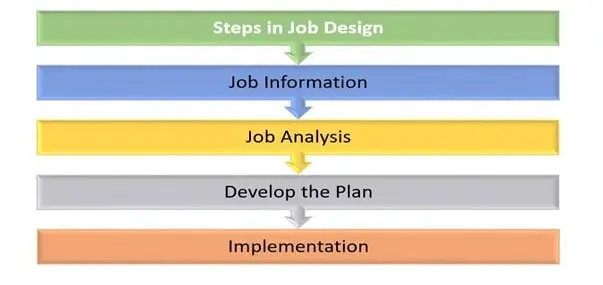
Job information
HR needs to have the information about the job being performed by the employee; it not only helps in the evaluation of the compensation design for an employee but also gives the role clarity. Information that is not true may lead to disparities between the plan and its execution and then the evaluation. So it is important to have the proper documentation work about the role and duties be done on time and should be communicated properly to the employees. What all information to have:
-
Specific tasks, areas of responsibility, and examples of work being carried out
-
The fundamental purpose of the job to be done
-
Time spent on each task or specific area of responsibility to be done
-
Important of each element in the job and its relationship or ratio to the total operation of the job
-
Scope of the job and its impact on the operations
-
Working relationships with other players, like managers, team members, customers
-
Methods, techniques, and equipment that are used
-
Job climate that includes the work environment
-
What are the job conditions like discomfort, chasing deadlines, creativity and innovation, physical efforts, and innovations?
Job analysis
The next is to analyze all the information collected and the HR has to pick out the imperative and important aspect of the job that is required to be done and the responsibilities that are to be carried out in the job. For HR doing the Job analysis, it is better for them to have a line manager specific to that domain to be a part of the process for better accuracy. Not only do the duties and responsibilities of the job have to be kept in mind but HR also needs to see how the employees are feeling about the job, this can be done through a direct interview or through circulating a questionnaire so that the job design can be planned accordingly.
Develop the job design plan for the employee
On the basis of the information analyzed about the job and about how the employee feels about his/her job. To check, if there is any sign of discomfort or dissatisfaction regarding their job. When you have evaluated this information, you need to see which method of job design you have to apply for the employee. There are various job design methods which are explained below in this article.
Implementation
After deciding on the job design method to be rolled out, HR needs to implement it in a successful way, where the goal of the individual and the company are in alignment. And you also need to guide the employee at every step about their role and responsibilities and why it will be beneficial for them to carry out the action for a particular job design method.
Job Design Method & Techniques
There are broadly 4 types of Job Design methods and techniques that are used to bring some change in the job structure for an employee. Find below these methods and techniques of job design:
- Job Rotation
Job rotation is the lateral shift of the job role or positions, it happens between the job levels, and it cannot be mistakenly considered a promotion. As it does not help the person to move up the ladder of his/her career. It is done on a temporary basis where employees are moved back to their previous job after a stipulated time. It has many benefits like:
Learning: When the employees are getting the opportunity to carry out a new role, they will definitely get to learn one or the other thing. It becomes a great way to transfer, knowledge skills, and competencies that lead to human capital accumulation.
Flexibility: In a situation where there are more employees involved in job responsibility, then employees get more flexibility in performing the job role.
Employee replacement: - This technique saves the organization from the loss that it would be born when any of the employees suddenly leaves. Rotating employees in that role can help the organization for an immediate period. Here, the job rotation method becomes the savior.
- Job Enlargement
Job enlargement as the name suggests is about adding more responsibilities or activities in the same job to the employee. This means that employees will do different activities in the job that eliminates the boredom that the employee was going through, and it also eliminated the monotonous work of the employee. The benefits that the employee and the organization can yield from job enlargement are:
Earn a higher wage: - Employees can earn higher wages after getting more responsibilities added to their role.
Give more autonomy: - Along with autonomy comes accountability and responsibility. As the person is now handling more responsibility, they are given autonomy to do their job and they are more accountable for the result that they are extracting.
Career growth: - When additional responsibility is given to the employees, they are also given the training so that they carry out the duties successfully. This helps the employee in learning new skills that can help in their further career. When employees realize that the organization is considering their individual growth, then there is less attrition rate in the country leading to the benefit of the organization.
- Job Enrichment
This is the method where the motivators are added to the existing job. Like adding skill variety, extra tasks, giving feedback, meaning to the job, and increasing autonomy. Through this method, the job is made more meaningful for the employee.
If you are getting confused between job enlargement and job enrichment here is the difference: job enlargement makes the job more motivating by broadening the job of the employees, whereas job enrichment is when we are adding motivators to the existing job of the employee.
Benefits for job enrichment are:
Increase satisfaction: when the meaning of the job is enhanced then the employee is more satisfied with the job. As the intensity and scope of the work have been increased, employees feel happier with the job.
Better psychological states: It leads to increased meaningfulness for the work which leads to high-quality results from the employee. And increased employee experience.
- Job Simplification
It is the process where a few tasks are removed from the job to make the job more focused on the main job. The aim behind this method is to initiate improved work methods that can maximize the output along with minimizing expenses and costs.
Obviating unnecessary work: as we studied earlier that 34 % of the employees said they wasted time because of long hours. These long hours are taken by work that is unnecessary and that does not fetch any output or profit. Hence, removing such work will help the employee do the important required work
Make employee more focused: when the extra work is removed employee is left with important and output-driven work, which brings more profit and minimizes the cost of the employee.
Till now you have got a lot of information about job design, what is job design definition, what are the steps to plan job design, and what are the methods of job design. This information is imperative for not only Human Resource professionals but for every working professional, as it is planned for them, they should know why is it being done or what is the benefit of Job design.
Importance and Benefits of Job design
Job design is an important and crucial part of human resource management. It has a direct impact on the productivity and efficiency of the organization. It also contributes significantly to the enhancement of working conditions.
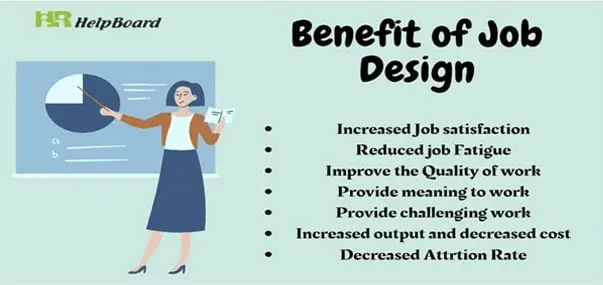
It creates the tasks that must be completed in order for the project to be completed effectively. Job design yields many benefits for the organization as a whole and on an individual level as well:
-
Increased job satisfaction: Job design is an imperative part of the organization's operation, as it helps the HR department to reduce the negative component of the employees, work-life.
-
Eliminate on-the-job fatigue: It helps in reducing job dissatisfaction, which comes out as a result of the monotonous role of the employee, reducing the on-the-job fatigue that the employee is going through.
-
Improve the quality of work: when all the negative factors of the job are removed, the organization has the chance to get the optimum level of output from employees.
-
Provide meaning to work: job design methods are planned such that employees get more meaning from the job they are doing.
-
Provide challenging work: When an employee is given more responsibility or a different task rather than a monotonous task then they have more challenges to overcome in their job which keeps their motivation level up.
-
Increased output and decreased cost: - the optimum level of output s received from the employee and as attrition and all the negative aspect are removed, the organization incurs less cost.
-
Decrease attrition rate: Both these components can lead to an increased attrition rate. So, with the help of job design attrition rate in the company is also handled. The high attrition rate in any organization is an alarming state for the HR department that needs to be taken care of on an immediate basis.
Job design stops this acceleration of the situation by giving the employees some change in their monotonous job. Research is done by salary.com suggests the reason, why employees waste their time, the research also suggests that:
-
39% of the respondents in the survey spend just one hour a week or even less on non-work-related stuff.
-
29 % of the respondents spend 2 hours a week on the computer at work.
-
21 percent of the respondents, waste up to 5 hours a week
-
And at last, only 3 percent of the respondents spend 10 hours a week on their personal tasks.
-
Reasons for the respondents to waste their time were:
-
35 % of employees reported that they waste time because they no longer find their job challenging
-
34 % of employees report that they wasted time due to the hours which are too long
-
32 % of the employees said that their company did not provide an incentive to them even if they work hard.
-
30% are the employees that are unsatisfied with their job
-
23% of the employees said that they are bored with their job now
With these figures, you have got the picture of why job design is imperative and should be carried out carefully and successfully.
Use of Abraham Maslow’s hierarchy of needs in Job Design
Intrinsic motivation or extrinsic motivation is imperative for an employee’s productivity. When the Motivation level goes down you will see the quality of the work yielded by an employee is not up to the mark. A job design plan brings the motivation level of employees back to the place. Everybody is familiar with Maslow's hierarchy of needs which has two versions one which is dedicated to a layman and the other includes the stages of needs for an employee. These needs are the motivating factor for an employee to work. Job design should be made after identifying the current need of the employee and then planning job design in such a way that the employee moves up the ladder of Abraham Maslow’s hierarchy of needs.
Abraham Maslow’s Hierarchy of need:
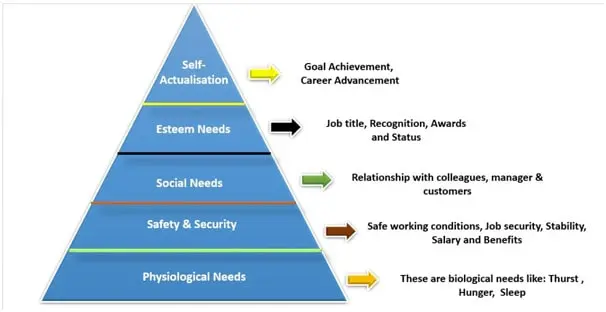
For Example: If you identify that the employee is on the second stage, that is, on the safety and security needs then the employee is looking for a more secure and stable role in the organization. You will need to plan a job design method that is not very deviant from the current role to make the employee believe that organization is looking for a long-term relationship with her/him like Job Enlargement and Job Enrichment.
To better understand this theory of motivation, human resource needs to understand the job characteristics and link the two in an aligned manner to have a job design plan which is successful for a longer duration.
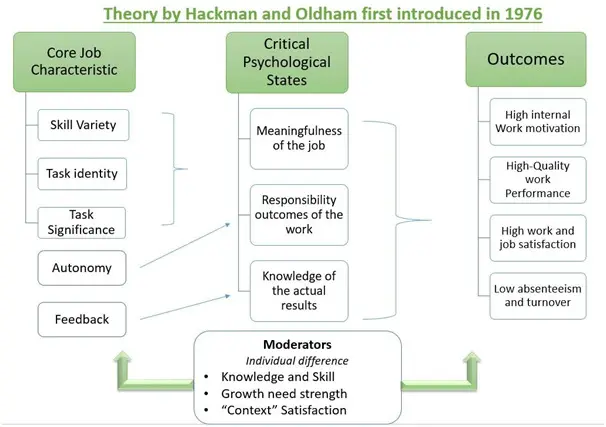
HR can also communicate these elements to managers and employees so that they can work on an individual level.
Job Design for Employers
The Research claims that the way a job is done has an impact on an employee's confidence attitude, self-belief, and emotions. It directly links with employee motivation, work performance, job happiness, phycological and mental wellness, and illness, absence or leaves are among them.
A Poorly designed job may cause losses and become expensive to an organization because it enhances the time period for employees to master skills and new systems or necessitates the hiring of more experienced and trained employees.
Tips for Job Design
For Successful planning and implementation of the Job design, you should follow the following tips:
-
Keep the management and the employees on the same page about what you are planning, that is, you need to keep your communication clear and transparent. Use a mode of communication through which you can easily communicate the plan to both the players and make sure there is no distortion in the meaning that you are planning to put across.
-
Understand the need: you may be required to carry out Training Need Analysis (TNA) to identify which type of training the employee needs. According to which HR can go ahead with deciding the type of Job design method. If you plan to execute Job design without identifying the need of the employee, you might be forcing the plan on the employee which may result in employee resistance.
-
Involving managers and the employee at every step for a better result, involving them in the decision-making process yields a better result. The players who will be affected the most; have to be involved for successful execution.
-
Support the employee in the execution stage: Take feedback from the employee during the implementation stage. As their job satisfaction has to be the priority of the management because the job design is being carried out to benefit the employees, which will eventually benefit the organization as a whole.
At the time of designing a job, the following questions should be considered:
-
Does the job or position have the appropriate level of variation?
-
What level of responsibility does the job position entail?
-
Does the Job provide enough opportunity in participating in decision-making?
-
What level of autonomy does the role provide?
-
Does the job performance in a safe and healthy environment?
-
To what degree are the responsibilities and tasks to be completed?
-
What level of support, reward and recognition does the role provide?
-
How much performance feedback is provided?
- Que: What exactly is job design, and why is it important?
- Ans:
Job design is the process of determining the specific job duties and responsibilities that employees will be responsible for. It's a time-consuming operation. It enables companies to match employees' skills and abilities to job requirements. It ensures the organization's efficiency and effectiveness.
- Que: What is the job design method?
- Ans:
The job design method includes job rotation, simplification, enlargement, and enrichment. Job design is inextricably linked to job analysis. The job analysis offers information on the job, as well as the skills and expertise that the incumbent will need to complete the task.
- Que: What is a job design analysis?
- Ans:
The practice of breaking down a job or vocation into its constituent pieces, such as organizational structure, work activities, and informational content, is referred to as job design analysis.
- Que: What are the four approaches to job design?
- Ans:
Job rotation, job engineering, job enlargement, and job enrichment are four popular job design approaches. Job design methods have two aspects: effect and complexity.
- Que: What are the goals of the job design process?
- Ans:
The fundamental goal of job design is to enhance productivity by optimizing work processes and ensuring that the correct value is generated. This is accomplished through defining roles, processes, and procedures, minimizing repetitious components within and across tasks, and increasing worker accountability.
Frequently Asked Questions of Job Design
Latest JobsView All
-
 Area Sales Manager @ Ghaziabad... Delhi 12 Nov 2025
Area Sales Manager @ Ghaziabad... Delhi 12 Nov 2025Ascent Human Solutions Pvt. Ltd..
-
 Assistant Manager/ Manager - Sales MV ... 13 Nov 2025
Assistant Manager/ Manager - Sales MV ... 13 Nov 2025Ascent Human Solutions Pvt. Ltd..
-
 Senior Manager Marketing – K 12 Busin... New Delhi 12 Nov 2025
Senior Manager Marketing – K 12 Busin... New Delhi 12 Nov 2025Ascent Human Solutions Pvt. Ltd..
-
 Senior Manager - Business Development -... Gurgaon 13 Nov 2025
Senior Manager - Business Development -... Gurgaon 13 Nov 2025Ascent Human Solutions Pvt. Ltd..
-
 Sr Manager - Brand & Communication @ De... Delhi 12 Nov 2025
Sr Manager - Brand & Communication @ De... Delhi 12 Nov 2025Ascent Human Solutions Pvt. Ltd..
RELATED ARTICLES
-
Law & Compliances Integrating Local Law 152 Gas Inspections Into Your Annual B... Explore
-
Human Resource Key Competencies to Look for in HR Trainees Explore
-
-
Performance management Employee Happiness and Workplace Happiness 2025 Explore
-
Performance management Boosting Employee Engagement and Knowledge Retention through... Explore
-
Human Resource Why Employee Voice Matters? Explore
-
-
-
Human Resource HR Planning - How to Manage Your Leave Policy Structure Explore
-
Human Resource Mastering Leadership: The Three C's of Success Explore
-
-


